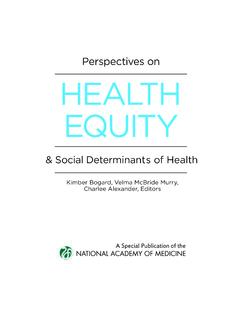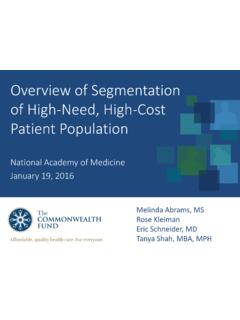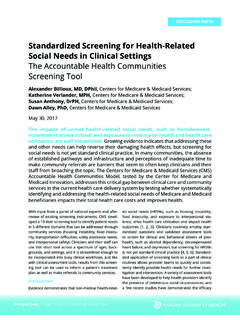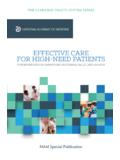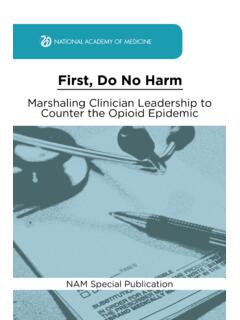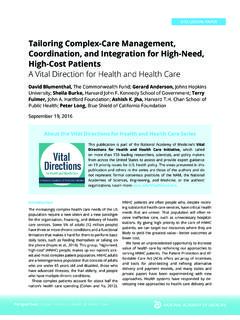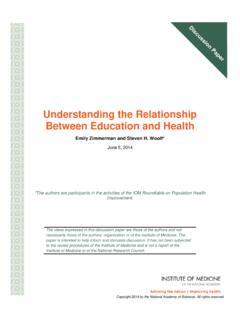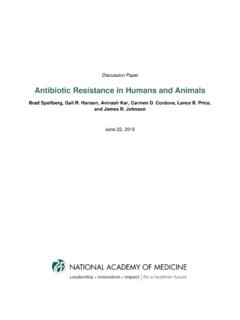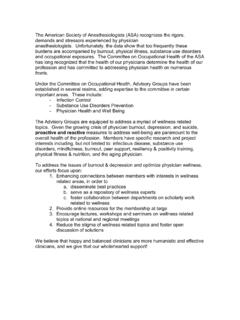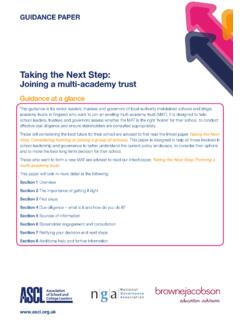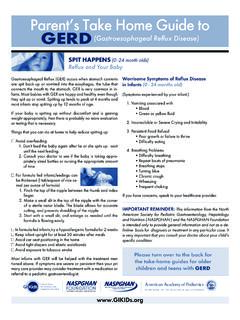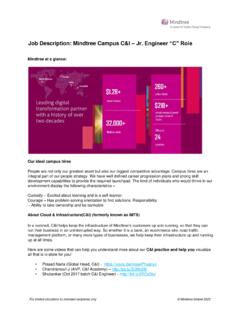Transcription of The Future of Nursing 2020–2030 - National Academy of ...
1 Consensus Study ReportHIGHLIGHTSThe Future of Nursing 2020 2030 Charting a Path to Achieve Health EquityThe decade ahead will test the nation s nearly 4 million nurses in new and complex ways. Nurses live and work at the intersection of health, education, and communities and in a wide array of settings and practice at a range of professional levels. They are often the most frequent line of contact with people of all backgrounds and experiences seeking care and they represent the largest of the health care professions. THE ROLE OF NURSES IN ADVANCING HEALTH EQUITYA nation cannot fully thrive until everyone no matter who they are, where they live, or how much money they make can live their healthiest possible life, and helping people live their healthiest life is and has always been the essential role of nurses. Nurses have a critical role to play in achieving the goal of health equity, but they need robust education, supportive work environments, and autonomy. Accordingly, at the request of the Robert Wood Johnson Foundation, on behalf of the National Academy of Medicine, an ad hoc committee under the auspices of the National Academies of Sciences, Engineering, and Medicine conducted a study aimed at envisioning and charting a path forward for the Nursing profession to help reduce inequities in people s ability to achieve their full health potential.
2 The ultimate goal is the achievement of health equity in the United States built on strengthened Nursing capacity and expertise. (For a full list of the committee s recommendations, view the Recommendations insert.)The committee developed a framework identifying the key areas for strengthening the Nursing profession to meet the challenges of the decade ahead. These areas include the Nursing workforce, leadership, Nursing education, nurse well-being, and emergency preparedness and response, as well as responsibilities of Nursing with respect to structural and individual determinants of health. Nurses play multiple roles in acute care, community, and public health settings, through which they can influence the medical and social factors that drive health outcomes, health equity, and health care 2021 ACTING NOW TO IMPROVE THE HEALTH AND WELL-BEING OF THE NATIONThe demand for nurses will increase in the decade ahead due to the health needs of the aging population, increases in behavioral and mental health conditions, increases in lack of access to primary health care, high maternal mortality rates, worsening physician shortages, and other sociodemographic factors and health workforce imbalances.
3 The Nursing workforce will also face challenges from within the health care system and the health care workforce, and from health-related policies and other factors that affect the scope of practice, size, distribution, diversity, and Nursing education. In the current system, care is often disjointed. Nurses provide care coordination that helps ensure seamless care, serve as advocates for patients and communities, and assist in increasing individuals trust in and engagement with the health care BARRIERS TO EXPAND THE CONTRIBUTIONS OF Nursing The past two decades have seen progress in lifting state-level regulations restricting the scope of practice for advanced practice registered nurses (APRNs), but 27 states still do not allow full practice authority for nurse Eliminating these restrictions so APRNs can practice to the full extent of their education and training will increase the types and amount of high-quality health care services that can be provided to those with complex health and social needs.
4 Institutional barriers also need to be lifted for APRNs and other nurses, including registered nurses (RNs) and licensed practical nurses (LPNs), to allow them to practice to the top of their education and training. DESIGNING BETTER PAYMENT MODELSThe current payment systems are not designed to pay for services that address social needs and social determinants of health (SDOH) nor advance health By supporting team-based care, improved communication, and proven interventions and strategies that can reduce health disparities, payment systems can enable nurses to make these essential contributions to improving care and outcomes for all patients. New payment models ( , accountable care organizations, accountable health communities, value-based payment) can give health care organizations the flexibility to address social needs and SDOH and advance health Nursing EDUCATIONN ursing education coursework and experiential learning that prepare students to promote health equity, reduce health inequities, and improve the health and well-being of the population will build the capacity of the Nursing workforce.
5 Substantive education in community ( , schools, workplaces, home health care, public health clinics) and telework settings allows Nursing students to learn about the broad range of care environments and to work collaboratively with other health and non-health professionals. Additionally, Nursing schools should continue expanding efforts to recruit and support diverse students and faculty that reflect the populations they serve, through holistic efforts to support, mentor, and sponsor students and faculty from a wide range of backgrounds. VALUING COMMUNITY AND PUBLIC HEALTH Nursing Community and public health nurses play a vital role in advancing health equity. School nurses, for example, are front-line health care providers, serving as a bridge between the health care and education systems and other sectors as well as links to broader community health issues through the student populations they serve. More school nurses need the practice authority and payment structure to address complex health and social needs.
6 The COVID-19 pandemic has also heightened the need for team-based care, infection control and prevention, person-centered care, and other population-based skills that reflect the strengths of community and public health APRNs hold at least a master s degree in addition to the initial Nursing education and licensing required for all RNs, and may continue in clinical practice or prepare for administrative and leadership The conditions of the environments in which people live, learn, work, play, worship, and age that affect a wide range of health, functioning, and quality-of-life outcomes and NURSES ROLES AS LEADERS AND ADVOCATESA new generation of nurse leaders is now needed one that recognizes the importance of diversity and equity and is able to use and build on the increasing evidence base supporting the link between SDOH and health status. This requires the contributions of nurses in all roles and settings in a collaborative system of leadership. Nurse leaders can play an important role in acknowledging the history of racism within the profession and health care and help mitigate the effects of discrimination and implicit bias on health.
7 PREPARING NURSES TO RESPOND TO DISASTERSThe COVID-19 pandemic has revealed chasms within an already fragmented health care system, resulting in significant excess mortality and morbidity and glaring health inequities. Most affected are communities of color, who suffer from the compound disadvantages of racism, poverty, workplace hazards, limited health care access, and pre-existing health conditions. Articulating the roles and responsibilities of nurses in disaster response and public health emergency management is critical to the nation s capacity to plan for and respond to these types of THE HEALTH AND WELL-BEING OF NURSESN urses health and well-being are affected by the demands of their workplace, and in turn affect the quality of and safety of the care they provide. Thus, it is essential to address the systems, structures, and policies that create workplace hazards and stresses that lead to burnout, fatigue, and poor physical and mental health among the Nursing workforce.
8 The pandemic has illuminated and exacerbated the day-to-day demands of Nursing . Nurses often cope with unrealistic workloads; insufficient resources and protective equipment; risk of infection; stigma directed at health care workers; and the mental, emotional, and moral burdens of caring for patients with a new and unpredictable disease and helping with contact tracing and testing. To help address the many SDOH, nurses need to first feel healthy, well, and supported. Policy makers, nurse employers, Nursing schools, nurse leaders, and Nursing associations all have a role in achieving this goal. Ultimately, the health and well-being of nurses influence the quality, safety, and cost of the care they provide, as well as organizations and systems of REMARKSN urses are bridge builders and collaborators who engage and connect with people, communities, and organizations to promote health and well-being. They need ongoing support from the systems that educate, train, employ, and enable nurses to advance health equity.
9 The COVID-19 pandemic has starkly revealed the challenges nurses face every day, and has added significant new challenges. It has also given some nurses more autonomy, shifted payment models, and sparked overdue conversations about dismantling racism in health care. Policy makers and system leaders should seize this moment to support, strengthen, and transform the largest segment of the health workforce so nurses can help chart our country s course to good health and well-being for all. Copyright 2021 by the National Academy of Sciences. All rights on the Future of Nursing 2020 2030 Mary K. Wakefield (Co-Chair) The University of Texas at AustinDavid R. Williams (Co-Chair)Harvard UniversityMaureen BisognanoInstitute for Healthcare ImprovementJeffrey BrennerJunaCarePeter I. BuerhausMontana State University Marshall H. ChinUniversity of Chicago Regina S. Cunningham Hospital of the University of Pennsylvania University of Pennsylvania Jos J. EscarceUniversity of California, Los Angeles Greer GlazerUniversity of Cincinnati Marcus HendersonFairmount Behavioral Health System University of Pennsylvania Angelica MillanCounty of Los Angeles Department of Public HealthJohn W.
10 RoweColumbia UniversityWilliam M. Sage The University of Texas at Austin Victoria L. TiaseNewYork-Presbyterian Hospital Winston WongUniversity of California, Los AngelesStudy StaffSuzanne Le MenestrelStudy Director (from June 2020)Susan B. HassmillerSenior Scholar in Residence and Advisor to the President on Nursing , National Academy of Medicine Jennifer Lalitha FlaubertProgram Officer Adrienne FormentosResearch Associate Tochi Ogbu-MbadiughaSenior Program Assistant (from October 2020) Cary HaverStudy Director (until June 2020) Lori BrenigSenior Program Assistant (until May 2020) Carol SandovalSenior Program Assistant (until September 2020) Ashley Darcy-MahoneyNational Academy of Medicine Distinguished Nurse Scholar-in-Residence (August 2020 to August 2021) Allison SquiresNational Academy of Medicine Distinguished Nurse Scholar-in-Residence (March 2019 to August 2020) Sharyl NassSenior Director, Board on Health Care ServicesTo read the full report, please visit Study SponsorRobert Wood Johnson Foundatio
